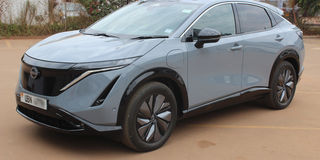The Nissan Ariya covers 500km when fully charged

Measuring in at 182.9 inches long, the Ariya is similar in length to the popular Nissan Rogue. PHOTOs/Roland D. Nasasira
What you need to know:
With its sleek design, advanced technology and impressive performance, it is clear that the Ariya is paving the way for the future of transportation.
The first functional feature I notice on the purely electric Nissan Ariya is the daytime running lights (DRL) turning on automatically. Its interior design is also a beauty to behold. First, the dashboard has a cocktail of functional information and features to interact with. Apart from a digital speedometre positioned behind the steering wheel, it also shows the battery consumption for the previous routes. Its mileage can also be saved or set to read in miles or kilometres or any other distance units.
The roof opens to let in natural light or fresh air in case you do not want to drive with the air conditioner on. The material that covers part of the door and dashboard trims is neither cloth nor leather, but comfortable enough to use, except the purely leather door arm rests.
Unlike the stationary middle consul in your ordinary car, the one in the Ariya can be extended to the front or rear to provide ample legroom and a left arm rest. The lock and open top of the consul has a wireless charging system where you place your phone to charge.
Connectivity
The Ariya has an inbuilt global positioning system (GPS) customised to Uganda. This can, however, be reset to any other country the car is taken. Connectivity is almost instant if you have android auto or Apple Carplay. Its indicator knobs are on the left while the wiper switch is on the right. The rest of the functions such as cruise control, phone pairing, phone call answering and music volume control on the steering wheel and many more for driver comfort are at your disposal.
To discover more features, my test drive started at Kitgum House on Jinja Road to Prince Charles Drive in Kololo via Yusuf Lule Road, Lumumba Avenue and Nakasero.
To adjust the steering wheel to a comfortable driving position, I raised the steering by holding a button on the left hand side of the wheel. The gearlever is stylish. To shift from parking mode to drive, reverse or neutral gear, you gently push the lever while pressing a button on the left side of the lever to change modes.
While reversing, the Ariya has all-round sensors and a clear active camera that displays a video of objects and reversing space at the rear. It will sound an alarm should anything come close to the car. After parking, the handbrake is engaged by gently pushing a button, which lights red. The same button is used to disengage the handbrake. It also has an inbuilt moving object detection system that alerts you if anything is moving closer to the vehicle. It is programmed to stop if it senses that you are not stopping as you get closer to any object or barrier.
Parking
In electric vehicles, you need to find the e-pedal used for regenerative power when you brake and autopilot to enable you park in certain spaces. When you choose the mode with a button on the middle consul, the dashboard displays whether you are driving in standard or sport modes. Sport holds up the vehicle, making you feel its bulk on the road.
The steering wheel is smooth and soft to turn. The fact that it has no engine and gearbox gives you a quiet driving atmosphere since it blocks outside noise. It also has lane departure systems. When changing lanes, the dashboard notifies you if it is safe to switch to another lane, a modern safety element coming out in most cars, not only electric ones.
Performance
The car’s beauty and its smoothness while driving matches its speed. It moves from zero to 100km/hr in less than 10 seconds. When the battery is fully charged, it covers 500km, meaning you can drive from Kampala City Centre to Kasese via Mbarara in western Uganda and recharge at Bushenyi Town in wester Uganda when making a return journey to Kampala.
Richard Bamujje, a marketing executive at Nissan Motorcare Uganda, says the faster you accelerate in the Ariya, the more battery it consumes. However, you can cover 500km when driving at an average speed of 100km/hr to 120km/hr. When the battery is running low, it shows how much mileage it can take you, a feature synonymous with most, if not all electric cars.
“When you cross to 180km/hr to 200km/hr, it starts to consume the battery. This means you will cover approximately 350km. At home, you need between Shs20,000 and Shs30,000 to charge it fully and it is cheaper compared to the current fuel prices,” Bamujje says of the car whose maximum speed is 240km/hr.
The Ariya does not only have a dual zone AC system where the co-driver and driver can enjoy different AC temperatures but it also has blind spot monitors and traffic signs that function intelligently. If you entered a junction at a speed of 30km/hr, it would alert you with a dark screen. If Uganda had electric car infrastructure such as charging points, the Ariya is able to map out where charging stations are located. It is an effort that is in the offing with selected fuel stations upcountry and in Kampala as electric car technology slowly penetrates the Ugandan market.
According to Bamujje, the most common routine of maintaining the Nissan Ariya is replacing tyres, brake pads and wiper blades.




